Aritra Sarkar
DeQompile: quantum circuit decompilation using genetic programming for explainable quantum architecture search
Apr 11, 2025Abstract:Demonstrating quantum advantage using conventional quantum algorithms remains challenging on current noisy gate-based quantum computers. Automated quantum circuit synthesis via quantum machine learning has emerged as a promising solution, employing trainable parametric quantum circuits to alleviate this. The circuit ansatz in these solutions is often designed through reinforcement learning-based quantum architecture search when the domain knowledge of the problem and hardware are not effective. However, the interpretability of these synthesized circuits remains a significant bottleneck, limiting their scalability and applicability across diverse problem domains. This work addresses the challenge of explainability in quantum architecture search (QAS) by introducing a novel genetic programming-based decompiler framework for reverse-engineering high-level quantum algorithms from low-level circuit representations. The proposed approach, implemented in the open-source tool DeQompile, employs program synthesis techniques, including symbolic regression and abstract syntax tree manipulation, to distill interpretable Qiskit algorithms from quantum assembly language. Validation of benchmark algorithms demonstrates the efficacy of our tool. By integrating the decompiler with online learning frameworks, this research potentiates explainable QAS by fostering the development of generalizable and provable quantum algorithms.
KANQAS: Kolmogorov Arnold Network for Quantum Architecture Search
Jun 25, 2024Abstract:Quantum architecture search~(QAS) is a promising direction for optimization and automated design of quantum circuits towards quantum advantage. Recent techniques in QAS focus on machine learning-based approaches from reinforcement learning, like deep Q-network. While multi-layer perceptron-based deep Q-networks have been applied for QAS, their interpretability remains challenging due to the high number of parameters. In this work, we evaluate the practicality of KANs in quantum architecture search problems, analyzing their efficiency in terms of the probability of success, frequency of optimal solutions and their dependencies on various degrees of freedom of the network. In a noiseless scenario, the probability of success and the number of optimal quantum circuit configurations to generate the multi-qubit maximally entangled states are significantly higher than MLPs. Moreover in noisy scenarios, KAN can achieve a better fidelity in approximating maximally entangled state than MLPs, where the performance of the MLP significantly depends on the choice of activation function. Further investigation reveals that KAN requires a very small number of learnable parameters compared to MLPs, however, the average time of executing each episode for KAN is much higher.
KetGPT - Dataset Augmentation of Quantum Circuits using Transformers
Feb 23, 2024Abstract:Quantum algorithms, represented as quantum circuits, can be used as benchmarks for assessing the performance of quantum systems. Existing datasets, widely utilized in the field, suffer from limitations in size and versatility, leading researchers to employ randomly generated circuits. Random circuits are, however, not representative benchmarks as they lack the inherent properties of real quantum algorithms for which the quantum systems are manufactured. This shortage of `useful' quantum benchmarks poses a challenge to advancing the development and comparison of quantum compilers and hardware. This research aims to enhance the existing quantum circuit datasets by generating what we refer to as `realistic-looking' circuits by employing the Transformer machine learning architecture. For this purpose, we introduce KetGPT, a tool that generates synthetic circuits in OpenQASM language, whose structure is based on quantum circuits derived from existing quantum algorithms and follows the typical patterns of human-written algorithm-based code (e.g., order of gates and qubits). Our three-fold verification process, involving manual inspection and Qiskit framework execution, transformer-based classification, and structural analysis, demonstrates the efficacy of KetGPT in producing large amounts of additional circuits that closely align with algorithm-based structures. Beyond benchmarking, we envision KetGPT contributing substantially to AI-driven quantum compilers and systems.
QKSA: Quantum Knowledge Seeking Agent -- resource-optimized reinforcement learning using quantum process tomography
Dec 07, 2021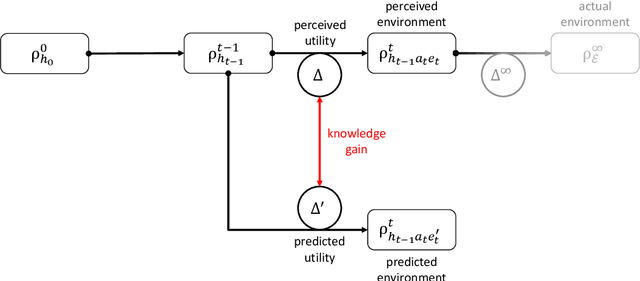
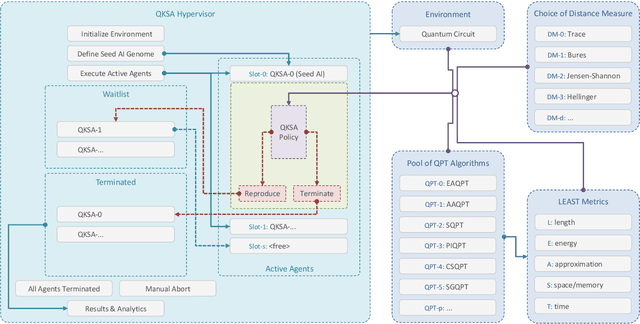
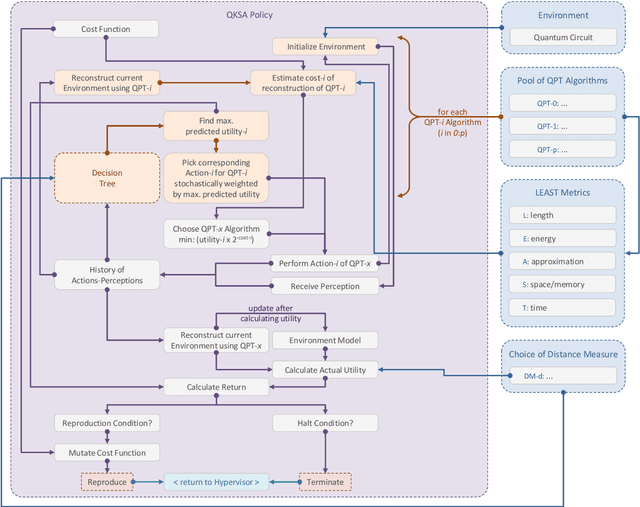
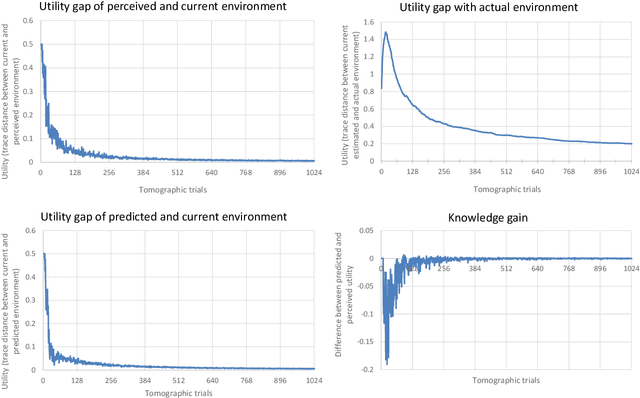
Abstract:In this research, we extend the universal reinforcement learning (URL) agent models of artificial general intelligence to quantum environments. The utility function of a classical exploratory stochastic Knowledge Seeking Agent, KL-KSA, is generalized to distance measures from quantum information theory on density matrices. Quantum process tomography (QPT) algorithms form the tractable subset of programs for modeling environmental dynamics. The optimal QPT policy is selected based on a mutable cost function based on algorithmic complexity as well as computational resource complexity. Instead of Turing machines, we estimate the cost metrics on a high-level language to allow realistic experimentation. The entire agent design is encapsulated in a self-replicating quine which mutates the cost function based on the predictive value of the optimal policy choosing scheme. Thus, multiple agents with pareto-optimal QPT policies evolve using genetic programming, mimicking the development of physical theories each with different resource trade-offs. This formal framework is termed Quantum Knowledge Seeking Agent (QKSA). Despite its importance, few quantum reinforcement learning models exist in contrast to the current thrust in quantum machine learning. QKSA is the first proposal for a framework that resembles the classical URL models. Similar to how AIXI-tl is a resource-bounded active version of Solomonoff universal induction, QKSA is a resource-bounded participatory observer framework to the recently proposed algorithmic information-based reconstruction of quantum mechanics. QKSA can be applied for simulating and studying aspects of quantum information theory. Specifically, we demonstrate that it can be used to accelerate quantum variational algorithms which include tomographic reconstruction as its integral subroutine.
QKSA: Quantum Knowledge Seeking Agent
Jul 03, 2021Abstract:In this article we present the motivation and the core thesis towards the implementation of a Quantum Knowledge Seeking Agent (QKSA). QKSA is a general reinforcement learning agent that can be used to model classical and quantum dynamics. It merges ideas from universal artificial general intelligence, constructor theory and genetic programming to build a robust and general framework for testing the capabilities of the agent in a variety of environments. It takes the artificial life (or, animat) path to artificial general intelligence where a population of intelligent agents are instantiated to explore valid ways of modelling the perceptions. The multiplicity and survivability of the agents are defined by the fitness, with respect to the explainability and predictability, of a resource-bounded computational model of the environment. This general learning approach is then employed to model the physics of an environment based on subjective observer states of the agents. A specific case of quantum process tomography as a general modelling principle is presented. The various background ideas and a baseline formalism are discussed in this article which sets the groundwork for the implementations of the QKSA that are currently in active development.
Quantum Accelerated Estimation of Algorithmic Information
Jun 01, 2020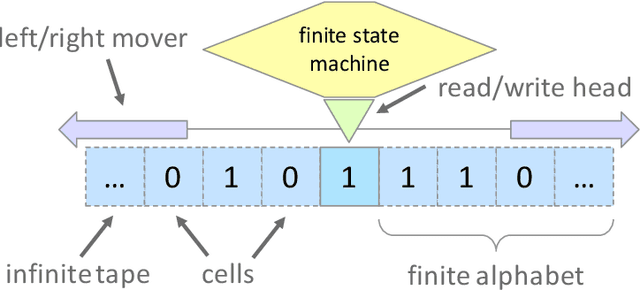

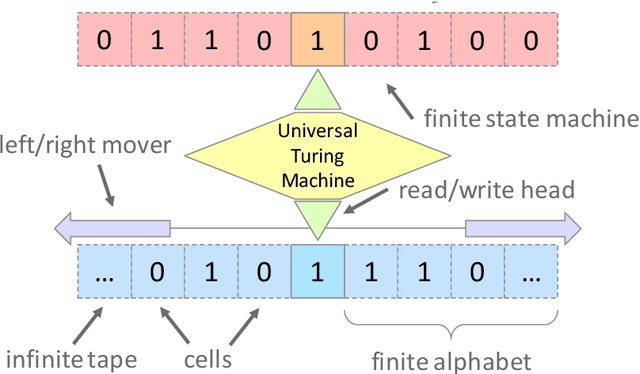
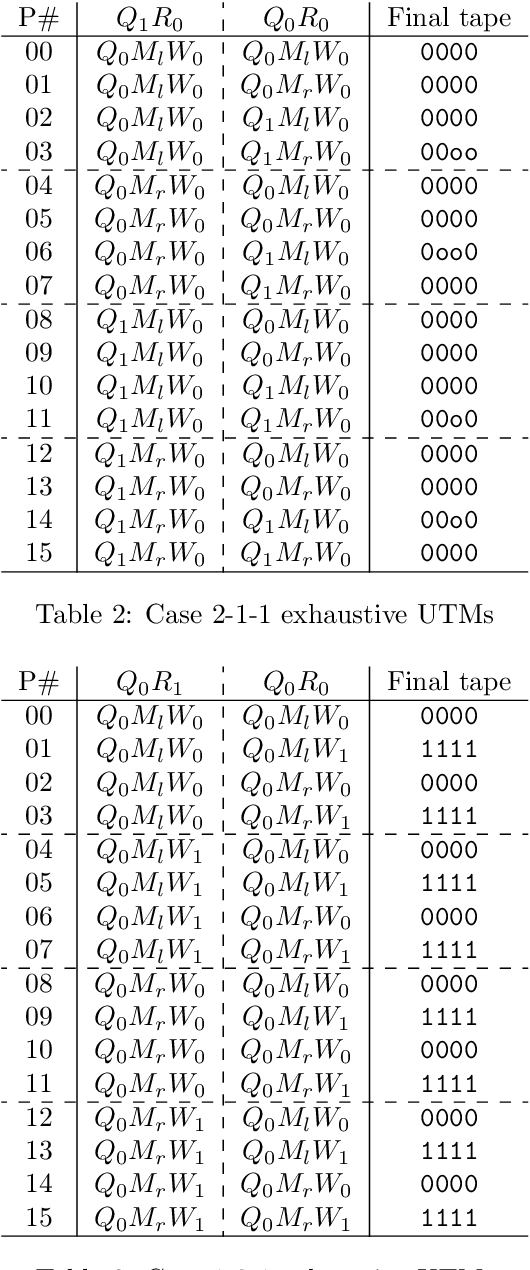
Abstract:In this research we present a quantum circuit for estimating algorithmic information metrics like the universal prior distribution. This accelerates inferring algorithmic structure in data for discovering causal generative models. The computation model is restricted in time and space resources to make it computable in approximating the target metrics. A classical exhaustive enumeration is shown for a few examples. The precise quantum circuit design that allows executing a superposition of automata is presented. As a use-case, an application framework for experimenting on DNA sequences for meta-biology is proposed. To our knowledge, this is the first time approximating algorithmic information is implemented for quantum computation. Our implementation on the OpenQL quantum programming language and the QX Simulator is copy-left and can be found on https://github.com/Advanced-Research-Centre/QuBio.
Integration and Evaluation of Quantum Accelerators for Data-Driven User Functions
Jan 25, 2020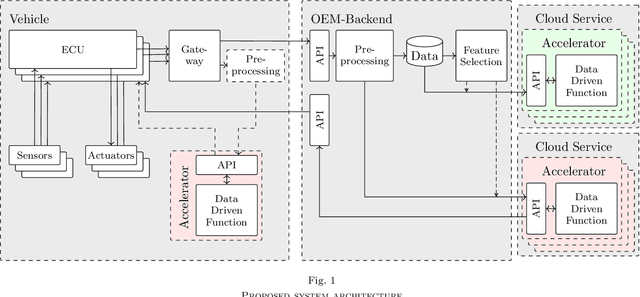

Abstract:Quantum computers hold great promise for accelerating computationally challenging algorithms on noisy intermediate-scale quantum (NISQ) devices in the upcoming years. Much attention of the current research is directed to algorithmic research on artificial data that is disconnected from live systems, such as optimization of systems or training of learning algorithms. In this paper we investigate the integration of quantum systems into industry-grade system architectures. In this work we propose a system architecture for the integration of quantum accelerators. In order to evaluate our proposed system architecture we implemented various algorithms including a classical system, a gate-based quantum accelerator and a quantum annealer. This algorithm automates user habits using data-driven functions trained on real-world data. This also includes an evaluation of the quantum enhanced kernel, that previously was only evaluated on artificial data. In our evaluation, we showed that the quantum-enhanced kernel performs at least equally well to a classical state-of-the-art kernel. We also showed a low reduction in accuracy and latency numbers within acceptable bounds when running on the gate-based IBM quantum accelerator. We, therefore, conclude it is feasible to integrate NISQ-era devices in industry-grade system architecture in preparation for future hardware improvements.
 Add to Chrome
Add to Chrome Add to Firefox
Add to Firefox Add to Edge
Add to Edge